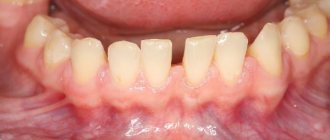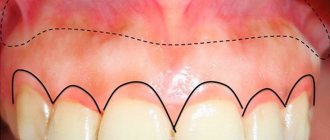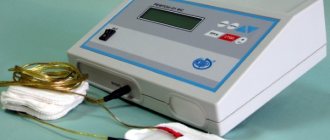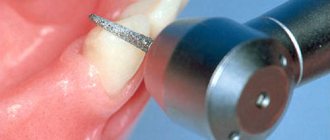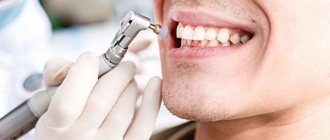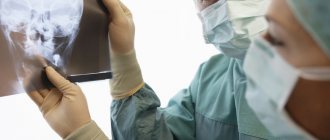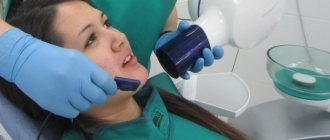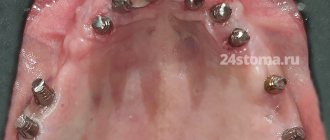Vestibuloplasty is a surgical method of correction of the oral cavity, in which, as a result of the redistribution of soft and mucous tissues, the space between the lip and the dentition deepens. The main purpose of such an operative procedure is to shift the internal contours of the mouth and the gum attachment zone, reducing and completely eliminating ischemia and excessive tension of the soft tissues and attached mucous surface of the gums, and improving blood circulation.
When should you consider vestibuloplasty?
Vestibuloplasty effectively alleviates the patient’s condition; you can resort to it by:
- cosmetic indications: pronounced aesthetic disturbances and cosmetic defects of the face caused by the small vestibule of the oral cavity;
- bite correction;
- increased tone of the mental muscles;
- correction and preparation of orthodontic mucous tissues before extensive treatment, prosthetics, implantation;
- disturbance of sound production and complicated phonation of some sounds due to the small oral vestibule;
Edlan-Meicher operation
The procedure is very popular today. Doctors use it more often than other options, because... the operation provides a successful positive result. Indicated for correction of the lower jaw mucosa.
The peculiarity of this type of vestibuloplasty is that the doctor first makes an incision on the mucous side of the lip along the entire length of the jaw bone, as in the photo. Next, he forms an area for a new vestibule of the oral cavity, moves submucosal tissues, muscles and tendons to this area. Then he sews the separated area of the mucosa together with the periosteum and protects the damaged area with a protective bandage.
Previously, gauze cloth soaked in iodine or other disinfectants acted as such a protective bandage. Today, experts give preference, for example, to Diplen Denta films. The films are impregnated with lidocaine, which allows the patient to easily endure the rehabilitation period and not experience pain. And also chlorhexidine, which eliminates the risk of infection entering the wound.
The photo shows the Edlan-Meicher operation
When is vestibuloplasty contraindicated?
In some clinical conditions there are a number of contraindications for this surgical intervention:
- complicated, multiple dental caries;
- pathologies of blood and hematopoiesis (leukemia, hemophilia), blood cancer;
- tendency to form keloid scars, collagenosis;
- maxillofacial osteomyelitis with destructive changes in bone tissue;
- recent radiation exposure to the cervical region and head;
- often recurrent chronic inflammation of the oral mucosa;
- the presence of malignant neoplasms;
- severe cases of diabetes;
- dysmorphophobia;
- cerebral vascular lesions;
- the patient has mental disorders, alcohol and drug addiction.
Preparing for surgery
To successfully undergo direct surgical intervention, dentists recommend following the following rules:
- undergo preliminary x-ray diagnostics of the operated cavity;
- Do not use any medications, especially painkillers. If you need to constantly take any medications, indicate this to the doctor performing the operation;
- solid food is excluded 8-10 hours before surgery;
- it is necessary to perform proper hygiene procedures to remove accumulated plaque;
- Before surgery, check with your doctor about any concerns you may have. This will help get rid of excessive anxiety and fear, and will allow you to have a positive psychological attitude towards the operation. In this case, the period of rehabilitation and recovery will take place in the shortest possible time, with minimal discomfort.
Preparation and other important features
In order for surgery on the tissues of the mandibular bone to be effective and with minimal complications, it is important to pay attention to the preparatory period. Before vestibuloplasty it is recommended:
- sanitize the oral cavity;
- carry out ultrasonic cleaning of enamel and periodontal pockets;
- Avoid smoking and alcohol three days before and after the expected date of surgery.
In addition to examining the oral cavity, assessing the importance and indications for vestibuloplasty, the doctor studies the hereditary, clinical and allergic history. It is important to tell your doctor about your current illnesses and drug treatment. If necessary, consultation with a doctor in the relevant field may be required. Vestibuloplasty is carried out in several main stages:
- Administration of anesthesia for pain relief. The drug is selected individually in accordance with the allergic history. Modern drugs are characterized by minimal aggression on the body and a low risk of allergic reactions.
- Performing vestibuloplasty according to the chosen method and surgical protocol. The total intervention time, regardless of the method of operation, does not exceed an hour.
- Upon completion of the operation, it is necessary to apply ice, apply lotions and rinses with chamomile decoction to constrict blood vessels and relieve tension.
Swelling and pain after vestibuloplasty are normal, but require attention. If pain increases and symptoms of an infectious-inflammatory process occur, you should consult a doctor.
Typically, vestibuloplasty does not cause difficulties or discomfort to patients. If you follow medical recommendations and oral hygiene, complications occur extremely rarely.
Vestibuloplasty is a routine surgical intervention in dentistry to eliminate a defect in the small vestibule of the oral cavity. This pathology is acquired or congenital and requires mandatory correction. The defect provokes tension in the gums under the incisors, which can be noticeable to others with a wide smile, as well as excessive mobility of the chin when swallowing water and food. When eating, the gums are constantly damaged, leading to circulatory disorders.
Main stages of vestibuloplasty surgery
Vestibuloplasty is usually performed under local infiltration anesthesia. In children and in severe cases, inhalation or intravenous general anesthesia may be used.
Stage 1. Aseptic treatment of the operated cavity.
Stage 2. Dissection, cutting the space into the depth of the mucous membrane, between the movable part of the jaw and the gums. Depending on the required results, it can be produced using various methods, which will be discussed below.
Stage 3. Peel off the inner surface of the lip using special scissors. At the same time, along the periosteum, submucosal tissues (muscle, fat, tendons) are carefully moved deeper into the frontal and lateral sections. If necessary, dental papillae (cords) are excised with a scalpel.
Stage 4. The necessary positioning of the detached flap is performed. In this case, the exfoliated tissue is moved to the desired location and evenly distributed throughout the entire depth of the newly formed vestibule. An important point is that it is necessary to completely remove fibrous and muscle fibers from both the periosteum and the detached flap.
Stage 5. Fixation of the mucosal flap with ligature threads to the periosteum.
Stage 6. Applying a special aseptic, dental, forming dressing to the wound surface to form a protective fibrin film that will protect it until complete healing. A pressure bandage is applied to the lip and chin area.
Vestibuloplasty in Moscow: price
The cost of the operation depends on the chosen technique, the equipment used, the type of anesthesia, and additional services. Prices from 8,000 to 14,000 rubles and above. The procedure performed using a laser will be more expensive than using a scalpel. The cost of anesthesia is calculated separately.
The FamilySmile clinic has verified prices and positive customer reviews. The cost of treatment is agreed upon with the patient before the start of the procedures. We employ highly qualified surgeons. They are proficient in various surgical techniques, including gentle tunnel correction for children and adults. We guarantee high results and no complications.
You can make an appointment with a doctor by phone.
Methods of mucosal dissection during vestibuloplasty
Clark's method
Vestibuloplasty according to Clark is an open method of vestibuloplasty and is the optimal solution for correcting the upper jaw. Its exceptional feature is that dissection can be performed over large areas of the oral vestibule without affecting the periosteal tissue. The incision is made to the depth of the oral mucosa along the transitional fold between the mucosa and the gums. The complex of submucosal tissues is moved along the periosteum line to a new depth, in the lateral section - 6-7 mm, in the frontal section - 10 mm. After the operation, a dental forming plate is applied, special attention is paid to the alveolar process, and it is covered with a special film. The period for complete healing is 15-20 days after surgery.
Tunnel vestibuloplasty
This method belongs to the closed methods of vestibuloplasty, is minimally traumatic (often used to eliminate dental problems in children) and can be used to correct both jaws. After infiltration anesthesia, dissection of the mucous membrane is performed, with 3 limited, small incisions made - in a vertical plane 20-25 mm long along the frenulum, along its entire length (from the place of attachment to the lip to the place of attachment to the gum) and two incisions in horizontal plane, along the connecting fold, towards the premolars with a length of about 20 mm. Through these incisions the mucous membranes are manipulated. Healing of the postoperative defect occurs quite quickly - 9-12 days from the date of surgery.
Edlan Meicher method
Most often used for correction of the lower jaw over the entire mucosal area. Local infiltration anesthesia is carried out using the hydropreparation method for better detachment of the mucosal flap. The mucosal surface is dissected along an arc parallel to the jaw line. At the same time, 10-12 mm recede from the gingival border of both canines; in the area of premolars and molars, 7-10 mm recede. Due to the positive dynamics and sustainable results, this method is widely practiced for vestibuloplasty and has a healing period of up to 2 weeks.
Glickman method
This vestibuloplasty is suitable for both local, small areas and relatively large areas. The dissection is made at the site of attachment of the lip, followed by detachment of soft tissue to a depth of 15 mm. The free edge of the resulting mucosal flap is sutured, offset, to the formed depression.
Schmidt technique
This technique involves, after an incision, detaching only the mucosal surface, while the periosteal tissue is not separated. The edge of the mucosal flap is immersed to the required depth of the cavity of the oral vestibule, and then sutured. A dental shaping bandage is applied to the operated areas, and a special pressure bandage is placed on the chin.
Limberg method
With this technique, 2 triangular opposing flaps of the lower lip are formed. The main dissection is along the crest of the frenulum, at the point of its attachment to the alveolar process. Next, two additional incisions are made: one at an angle of 70° from the main incision along the alveolar process, the other at an angle of 80° from the main incision along the mucous membrane of the lip. The length of the incisions in children is 0.5-2 cm, in adults - 2.5-3 cm. After gentle separation of tissue, the mucosal flaps are mutually moved and stitched with catgut.
Tunnel vestibuloplasty - a gentle method of vestibuloplasty
This method is considered universal, since it allows effective vestibuloplasty of the lower and upper jaw. The technique is a gentle technology and is often used to perform vestibuloplasty of the lower jaw in very young patients, for example, to solve orthodontic and speech therapy problems. Less trauma is achieved by making several small incisions instead of one large one.
A modern method of performing vestibuloplasty is surgery using a laser. The use of a laser in vestibuloplasty of the lower jaw can significantly reduce the pain of the procedure, as well as its traumatic nature for patients. The actions performed by a specialist will be similar to manipulations with other methods, but the process uses innovative instrumentation, which ensures maximum precision and accuracy of the incisions, and thanks to this, the mandibular vestibuloplasty operation takes place with less discomfort for the patient, and the wound heals much faster after it.
It is important to understand that the effectiveness and positive effect after vestibuloplasty depend largely not on the choice of technique, but on the qualifications and professionalism of the dentist who will perform the operation. In our Vanstom dental clinic, vestibuloplasty is performed by surgeons of the highest level of qualifications, and therefore by contacting us, you are guaranteed to receive a service of the European level of quality and a 100% positive result after vestibuloplasty!
Using a laser for vestibuloplasty
Vestibuloplasty using laser technologies is the most promising, innovative, minimally invasive surgical intervention. Using a laser, you can clearly predict the timing and results of plastic surgery, and clearly organize the entire treatment process.
Advantages of using laser in surgery:
- minimal impact on the nerve endings of the cut tissues, little pain;
- rapid postoperative tissue regeneration;
- precise and non-bleeding incision;
- burns of surrounding tissues are excluded, hypersensitivity of tooth enamel is not caused;
- prevention of disturbances in microcirculation processes;
- improved marginal fit of contacting surfaces;
- the possibility of infection of the operated tissues is excluded;
- destruction of pathological microflora, exclusion of purulent-destructive inflammatory processes;
- stimulation of tissue regeneration, absence of scar growths.
For vestibuloplasty, the following types of lasers are used:
- neodymium Nd:YAG laser - with good absorption in pigmented tissues (hemoglabin, melanin). Capable of cutting surfaces in continuous and pulse modes. The radiation is supplied via a flexible light guide;
- argon - with high speed and degree of polymerization of light-curing materials. When used, bleeding is effectively prevented and almost completely stopped;
- diode semiconductor laser - with good hemostatic effect and absorption by pigmented tissues. It has compact overall dimensions, is easily applicable in clinical settings, and has an effect that stimulates tissue regeneration.
Rehabilitation activities
Depending on individual characteristics, patients after vestibuloplasty may experience numbness and loss of sensitivity of the oral mucosa, swelling, and discomfort when speaking. During the rehabilitation period, you can get rid of these manifestations by doing the following:
- rinse your mouth with a doctor-recommended mouthwash after each meal. Light brushing of teeth with a soft brush on the 4-5th day after surgery;
- following special dietary recommendations. The main diet should consist of pureed, soft dishes, purees. Alcohol, spicy, sour, hot and solid foods, dairy products are prohibited (they can provoke the formation of unnecessary bacteria)
- simple, regular, restorative exercises: external, light massage of the skin covering the operated area, touching the area of the vestibule of the mouth with the tip of the tongue, periodically pouting the lips for at least 2 minutes/up to 5 times a day;
- Regular visits to the doctor to monitor recovery and regenerative processes. Clinical control 3.6 months after the intervention.
Vestibuloplasty of the lower jaw: what kind of operation is it?
Each person has his own individual structure of the oral cavity and jaws, and some people may experience a clear lack of space between the lip and dentition. This lack of space causes excessive muscle tension in this area, which is fraught with the development of a variety of dental diseases and pathologies. Vestibuloplasty surgery is designed to help eliminate the defect of excessive muscle tension.
The procedure of vestibuloplasty is carried out in dentistry and during the manipulations, the specialist surgically expands the space between the teeth and lip, shifting the muscle fibers in the desired direction. Most often, vestibuloplasty of the lower jaw is performed; less often, the procedure is prescribed for the maxillary region.
How to treat emerging complications
Ignoring rehabilitation recommendations can lead to the occurrence of certain pathologies, namely:
- severe bleeding. To eliminate it, you should use hemostatic tablets, make cold applications with liquids for better blood clotting;
- the appearance of ligature fistulas. May be caused by individual intolerance to suture material. In this case, you should consult a doctor to prescribe healing medications;
- excessive swelling. It may be an individual feature; as a rule, it completely disappears within 3-5 days from the date of surgery;
- loss of sensation in the operated area. The norm is that the period of complete restoration of sensitivity can range from six months to 9 months. Physiotherapy (hydromassage, paraffin baths) and rehabilitation exercises help speed up the process.
Sources used:
- Surgical dentistry: Textbook for medical dental institutes / A. I. Evdokimov, I. G. Lukomsky, I. M. Starobinsky; With the participation of Associate Professor G. A. Vasiliev and Professor M. B. Fabrikant. - M.: Medgiz, 1950.
- National Library of Medicine (USA)
- “Outpatient surgical dentistry” (Bezrukov V.)
- “Propaedeutics of surgical dentistry” (Soloviev M.)
Rehabilitation after vestibuloplasty
After surgery, there will be swelling, pain and some discomfort. In order for healing to proceed quickly and without complications, it is important to follow the following recommendations:
- Eliminate sour, salty, hot and spicy foods and drinks from your diet. Food should be warm so as not to irritate the oral mucosa. Avoid solid foods to avoid injury to the operated areas. You will also have to exclude fermented milk products, which leave plaque in the mouth.
- Brush your teeth carefully. Use a soft-bristled brush. After eating, rinse your mouth, but do not actively rinse. It is enough to hold the rinse liquid in the place where there are seams and then spit it out.
- For the first couple of days, try to talk and smile a little. On days 3-4, you can warm up using special exercises recommended by your dentist. This will help quickly restore muscle sensitivity.
